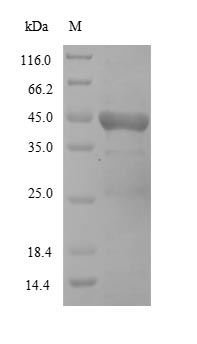Recombinant Newcastle disease virus Hemagglutinin-neuraminidase (HN) is expressed in E. coli and covers the 115-473 amino acid region of the protein. This partial protein carries dual tags—an N-terminal 10xHis-tag and a C-terminal Myc-tag—which help with purification and detection. SDS-PAGE analysis confirms the product purity exceeds 85%. This product is designed for research use only and is not intended for therapeutic or diagnostic applications.
The Hemagglutinin-neuraminidase (HN) protein appears to play a critical role in Newcastle disease virus biology. It handles viral attachment to host cells and helps drive the fusion process during viral entry. HN also shows neuraminidase activity, which seems essential for viral spread through cleaving sialic acid residues. This protein has become a significant target in virology research, particularly when studying how viral infection works.
Potential Applications
Note: The applications listed below are based on what we know about this protein's biological functions, published research, and experience from experts in the field. However, we haven't fully tested all of these applications ourselves yet. We'd recommend running some preliminary tests first to make sure they work for your specific research goals.
Newcastle disease virus biologNewcastle disease virus Hemagglutinin-neuraminidase (HN) is a complex viral glycoprotein that requires precise folding, proper disulfide bond formation, glycosylation at specific asparagine residues, tetramerization, and specific tertiary structure for its functional activity in receptor binding and neuraminidase activity. The E. coli expression system cannot provide the eukaryotic folding environment, oxidative conditions for correct disulfide bond formation, or glycosylation machinery required for this viral glycoprotein. The partial fragment (115-473aa) lacks critical N-terminal domains and the complete structural context. The dual N-terminal 10xHis-tag and C-terminal Myc-tag are large relative to the fragment and will severely sterically interfere with the protein's functional domains. The probability of correct folding with functional receptor-binding or neuraminidase activity is essentially zero.
1. Antigen for Anti-NDV Antibody Development
This application has limited utility. While antibodies can be generated against linear epitopes within this fragment, they will not recognize conformational epitopes of the full-length, glycosylated HN protein in its native viral context. Antibodies may primarily target the foreign tags rather than the viral protein domain.
2. Structural and Biochemical Characterization Studies
Basic biophysical analysis can be performed, but will not reflect native HN structure. The lack of glycosylation and proper disulfide bonding means results will describe an artificial protein fragment rather than the authentic viral glycoprotein. The tags will dominate all physical properties.
Final Recommendation & Action Plan
This dual-tagged HN fragment expressed in E. coli is fundamentally unsuitable for meaningful HN research due to the essential requirements for glycosylation, proper disulfide bonding, and tetramerization that cannot be met in this expression system. The protein should not be used for interaction studies and receptor binding, as they would yield biologically irrelevant results. Application 1 (antibody development) has severe limitations due to conformational epitope mismatch. Application 2 provides only a basic characterization of the tagged fragment. For reliable HN research, use full-length protein expressed in mammalian or insect cell systems that support proper glycosylation, disulfide bond formation, and native conformational epitopes.






